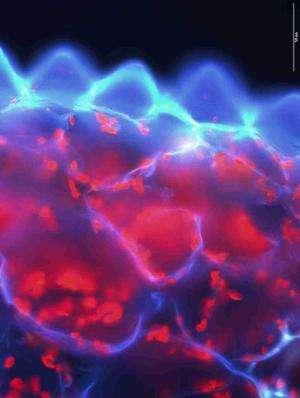South African 'living stone' plant adapts to extreme conditions in new ways

A unique plant that lives underground uses multiple mechanisms to boost photosynthesis and offers new insights into how plants adapt to extreme conditions, according to new research published October 23 in the open-access journal PLOS ONE, by Katie Field and colleagues at the University of Sheffield and other institutions.
Lithops are a type of South African "living stone," a mostly underground plant that lives in extremely dry conditions. This underground life makes it difficult to get enough sun to photosynthesize while still conserving as much water as possible. Lithops has many adaptations to help it do just this, including a top surface with "windows" of translucent pockets that allows light penetration to photosynthetic tissues deep within the subterranean leaf. Cleverly, these windows also have sunscreen properties to block out harmful UV light.
But too much light can also be a problem, resulting in excess energy that cannot be used effectively for photosynthesis. To offset this excess energy and protect themselves against damage, plants with above-ground photosynthetic organs use a process known as non-photochemical quenching (NPQ).
The authors here use a combination of techniques to show that individual leaves of a Lithops species have adaptations for both high light and shade tolerance, revealing for the first time the physiological mechanisms employed to optimize above-ground and subterranean photosynthesis while minimizing water loss within its extremely dry environment. Specifically, they found local differences in surface adaptations (windows) combined with regional physiological differences in the outer cell shape and chemistry and photosynthetic mechanisms, which are dependent on whether the leaf is deep underground or just above ground. This is the first time such physiological flexibility has been observed in Lithops, and offers new insight into how plants respond and adapt to extreme conditions.
More information: Field KJ, George R, Fearn B, Quick WP, Davey MP (2013) Best of Both Worlds: Simultaneous High-Light and Shade-Tolerance Adaptations within Individual Leaves of the Living Stone Lithops aucampiae. PLoS ONE 8(10): e75671. DOI: 10.1371/journal.pone.0075671
Journal information: PLoS ONE
Provided by Public Library of Science

















